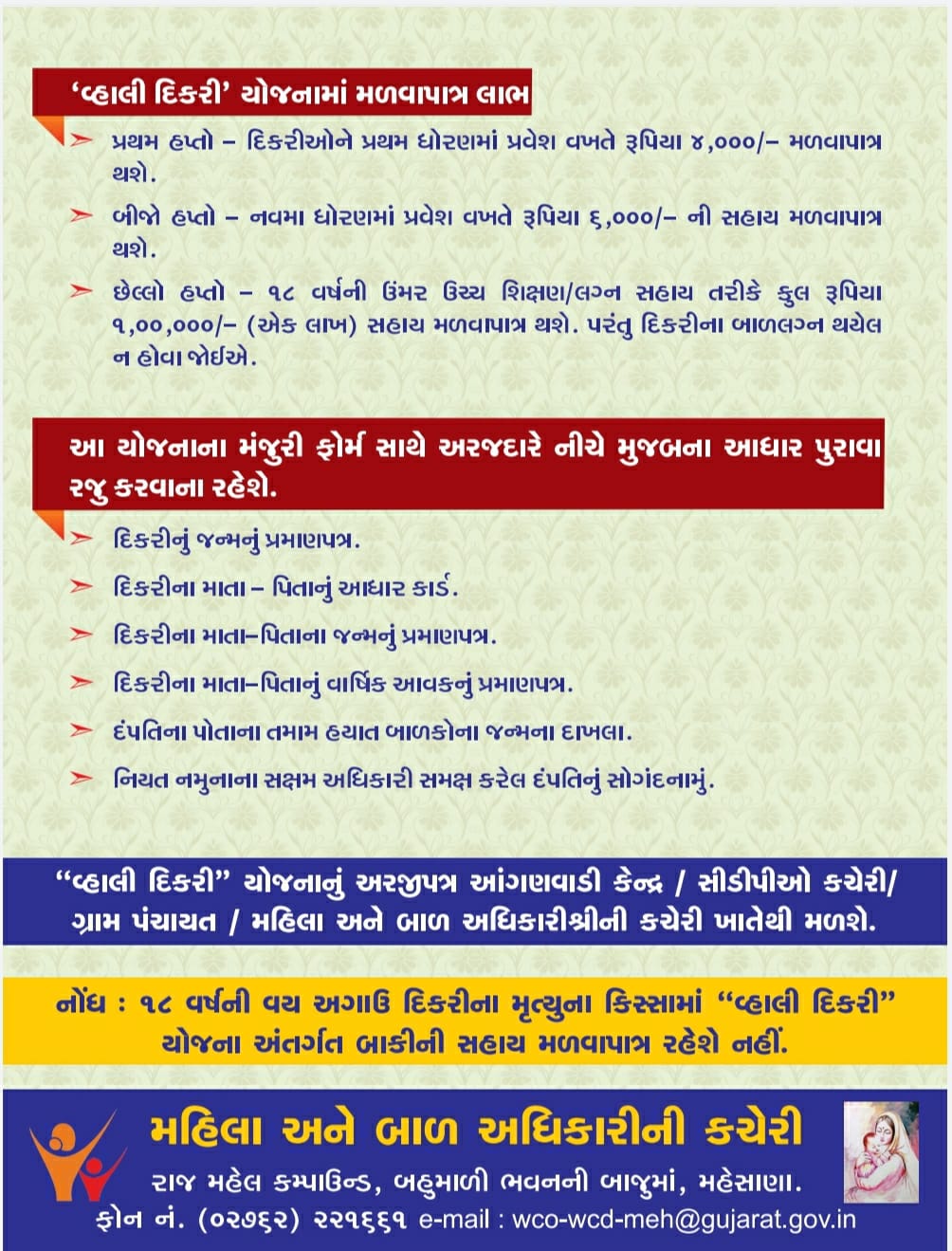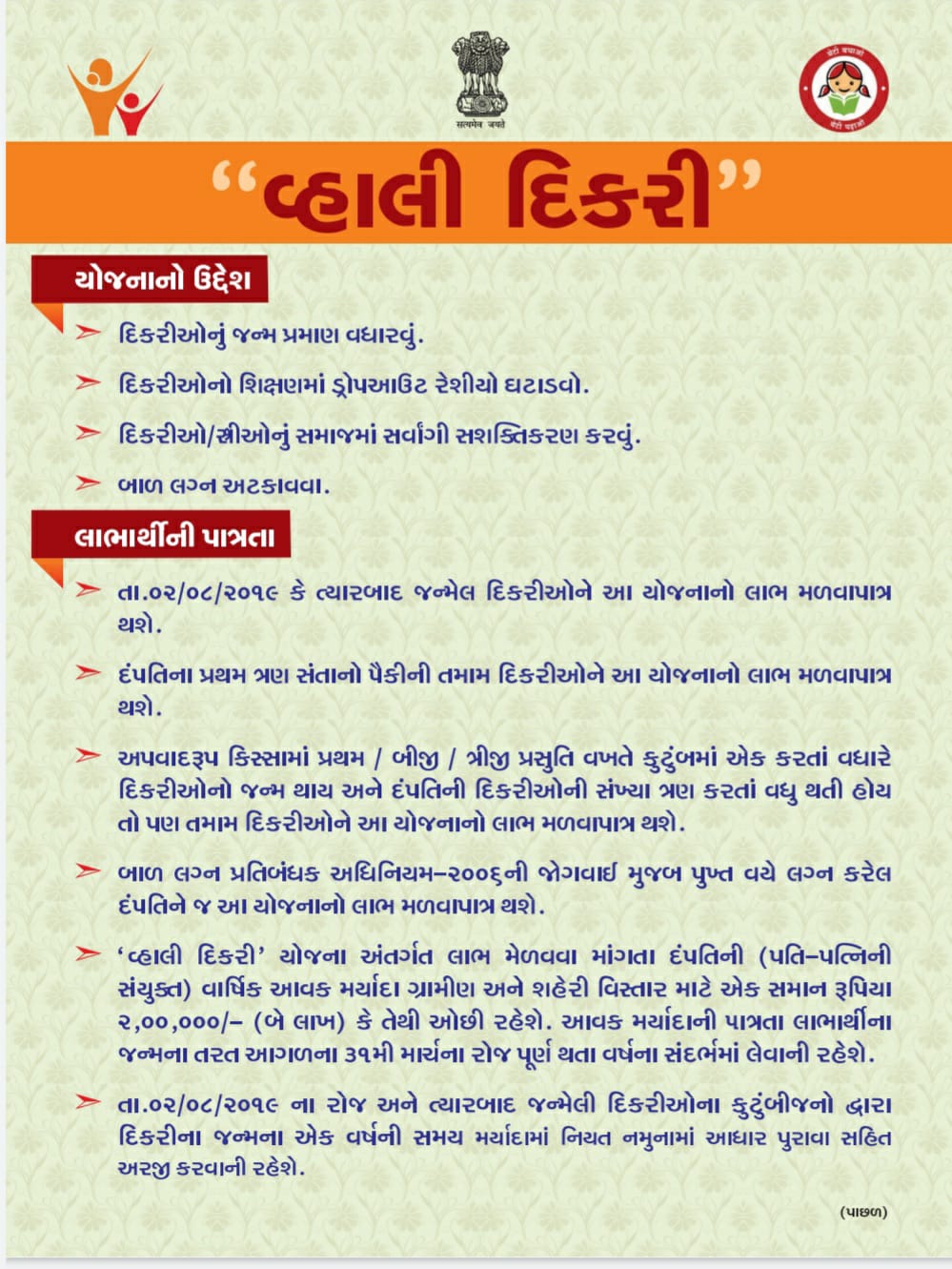The aim of the Gujarat Government’s beloved Daughter Scheme is to increase the birth rate of girls. Reduce the dropout rate of girls in education.
The objective of the current Daughter Scheme is to increase the birth rate of daughters. To reduce the dropout rate of daughters in education. To empower daughters/women in the society in general. To prevent child marriage. Eligibility of the beneficiary: Daughters born on or after 02/08/2019 will be eligible for the benefit of this scheme. All daughters among the first three children of the couple will be eligible for the benefit of this scheme. > In exceptional cases, if more than one daughter is born in the family during the first/second/third delivery and the number of daughters of the couple is more than three, then all the daughters will be eligible for the benefit of this scheme. As per the provisions of the Child Marriage Prohibition Act-2006, only couples married at the age of majority will be eligible for the benefit of this scheme. The annual income limit of a couple (joint husband and wife) seeking to avail the benefit under the ‘Hali Dikri’ scheme shall be Rs. 2,00,000/- (Two Lakhs) or less for both rural and urban areas. The eligibility of the income limit shall be taken with reference to the year ending on 31st March immediately preceding the date of birth of the beneficiary. The families of daughters born on or after 02/08/2019 shall have to apply in the prescribed format along with supporting documents within one year of the date of birth of the daughter. (Back)

Benefits available in the ‘Whali Dikri’ scheme | First installment – Daughters will be eligible for Rs 4,000 / – at the time of admission to the first standard. > Second installment – Rs 6,000 / – will be available at the time of admission to the ninth standard. Last installment – 18 years of age, a total of Rs 1,00,000 / – (one lakh) will be available as higher education / marriage assistance. But the daughter should not be child married. Along with the approval form of this scheme, the applicant will have to submit the following supporting evidence. Birth certificate of the daughter. Aadhar card of the daughter’s parents. Birth certificate of the daughter’s parents. Annual income certificate of the daughter’s parents. Birth certificates of all the surviving children of the couple. Affidavit of the couple made before the competent authority in the prescribed form. Application form for “Whali Dikri” scheme will be available from Anganwadi Center / CDPO Office / Gram Panchayat | Office of Women and Child Officer. Note: In case of death of daughter before the age of 18 years, the remaining assistance under “Whali Dikri” scheme will not be available. Office of Women and Child Officer Raj Mahal Compound, Next to Bahumali Bhavan, Mehsana.

મહત્વપૂર્ણ લિંક.
મહત્વપૂર્ણ લિંક
વ્હાલી દીકરી યોજનાની તમામ માહિતી માટે અહીં ક્લિક કરો
IMPORTANT LINK.
Download Vhali Dikri Yojna click here
Click HereClick Here to download Form
Vahali Dikri Yojana
How much assistance will be provided in Vahali Dikri Yojana? (Vahali Dikri Yojana Benefits)
In Vahali Dikri Yojana, the beneficiary daughter will be paid the assistance amount in three installments. Under this scheme, the beneficiary daughter will be eligible to get a total of Rs. 110000 (one lakh ten thousand) in three installments.
● In the first installment – The beneficiary daughters will be eligible to get Rs. 4000/- (four thousand rupees) at the time of admission to the first standard.
● In the second installment – The beneficiary daughter will be eligible to get Rs. 6000/- at the time of admission to the ninth standard.
The last installment will be.
● In the final installment – When the beneficiary daughter reaches the age of 18, a total of 100000/- (one lakh) assistance will be available as higher education/marriage assistance.
Note:- Under Vahali Dikri Yojana, if the beneficiary daughter dies before 18 years, the ‘remaining assistance’ will not be available.
Who will get Vahali Dikri Yojana? (Eligibility)
- Daughters born on or after 02/08/2019 will be eligible for the benefit of Vahali Dikri Yojana.
- All daughters of the first three children of a couple (husband and wife) will be eligible for the benefit of Vahali Dikri Yojana.
- In exceptional (special) cases, if more than one daughter is born in the family during the second/third delivery and the number of daughters of the couple is more than three, all daughters will be eligible for the benefit of this scheme.
- As per the provisions of the resolution regarding Vahali Dikri Yojana income limit, to get the benefit, the annual income limit of the couple (joint of husband and wife) (Vahali Dikri Yojana Income Limit) should be equal to Rs. 200000/- (Two lakhs) or less for rural and urban areas.
- As per the provisions of Child Marriage Prohibition Act-2006, only daughters of couples who are married at the age of majority will be eligible for the benefit of the Whali Dikri Yojana.
Document to avail the benefit of the Whali Dikri Yojana
- Birth certificate of the daughter
- Aadhar card number of the daughter (if any)
- Aadhar card of the parents
- Birth certificate of the parents
- Income certificate
- Birth certificates of all the surviving children of the couple
- Marriage certificate of the parents of the beneficiary daughter
- Affidavit of the couple made before the competent authority in the prescribed format of the Whali Dikri Yojana
- Copy of the applicant’s ration card.
Make information sharing mandatory..
The objective of the Gujarat Government’s Whali Dikri Yojana is to increase the birth rate of girls. Reduce the dropout rate in girls’ education.
